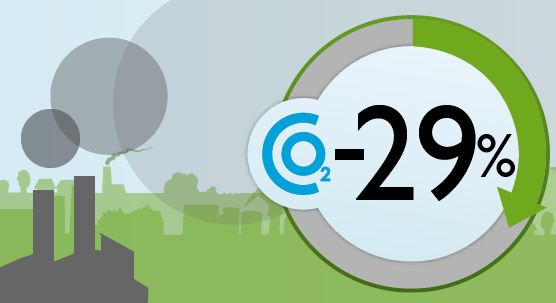Press release 2017-03-29 at 9:31

© SYKE
Emissions from municipalities in the Carbon Neutral Municipalities (HINKU) network declined by an average 29 percent in 2007 - 2015. The greatest decreases in emissions were in the municipality of Ii (50%), Kitee and Lieksa (36%) as well as Lohja and Rauma (35%). In other HINKU municipalities the average reduction in emissions was 23 percent.
The main reason for the reduction of climate emissions was a shift from fossil fuels to renewable energy. With district heating municipalities have used wood-based fuels to replace oil. In buildings that are not part of the district heating network investments have been made into heat pumps and wood energy. There have also been improvements in the energy efficiency of buildings, and electricity consumption has been reduced by changing how tasks are performed.
The greatest average reductions in emissions were in the energy sector. Emissions declined in HINKU municipalities especially in electric heating (50%), consumer electricity (41%), and in the industrial use of electricity (38%). Emissions were also significantly reduced in oil heating (45%) and in district heating (39%). If the same pace continues, oil heating will end in HINKU municipalities in the first half of the 2020s. There were lesser reductions in emissions in the waste sector (22%) and in transport (16%). Agriculture was the area in which achieving reductions in emissions was the most difficult.
Solar energy plants, smart lighting, and electric and biogas vehicles through joint procurement
In recent years the HINKU network has had a significant impact on the number of solar power plants in Finland. In 2016 a national joint procurement for solar power plants launched by the Finnish Environment Institute SYKE, KL-Kuntahankinnat Oy, and the HINKU network led to an order for about 100 solar power plants to Finland at one go. Kuntahankinnat tendered out a framework contract for solar power plants which includes financing. In this way the municipality does not need to reserve an investment budget for the procurement of a power plant, or deal with the tendering.
The framework contract is open for another three and a half years, and is open to all Finnish municipalities, associations of municipalities, municipally owned companies, and parishes. The SYKE HINKU team is applying the operating model this year to other energy technologies as well. For instance, smart illumination for streets and footpaths as well as electric and biogas cars are raising interest in many municipalities. The goal is to get an investment commitment of 30 million euros for investments for new joint procurements.
Municipalities have good possibilities for achieving carbon neutrality in 2030
HINKU municipalities are committed to reducing greenhouse gas emissions in their areas by 80 percent from the 2007 level by 2030. The municipalities are well on course to achieve their goals. The emissions have gone down very fast, especially after 2010.
The energy solutions of the HINKU municipalities have been cost-effective and have supported employment in the areas. The municipalities, local businesses, and residents have all implemented measures to reduce emissions.
"The experiences and results of the HINKU municipalities are appreciated now that Finland is looking for cost-effective ways to achieve the EU goals for reducing greenhouse gas emissions. A challenge can also be turned into an opportunity", says Professor Jyri Seppälä who is in charge of HINKU at the Finnish Environment Institute.
Hamina joins HINKU
The Hamina City Council decided to join HINKU on Tuesday, 28 March. Hamina's strengths include wind and solar power as well as a gas network, which creates possibilities for the extensive use of biogas in transport. According to a forecast on the development of emissions extending to 2030, Hamina's reduction in carbon dioxide emissions would be 80 percent from the emission level of 2007.
Further information
Professor Jyri Seppälä, director in charge of the project, Finnish Environment Institute (SYKE)
Tel. +358 295 251 629, firstname.lastname@ymparisto.fi
Head of the HINKU team, planning engineer Pasi Tainio, Finnish Environment Institute (SYKE)
tel +358 295 251 676, firstname.lastname@ymparisto.fi
HINKU communications, communications expert Ulla Ala-Ketola, Finnish Environment Institute (SYKE)
tel. +358 40 740 1656, firstname.lastname@ymparisto.fi
Mayors and contact persons of the HINKU municipalities (In Finnish)
Pictures for the use of the media
On-line services:
HINKU network has 36 municipalities
HINKU municipalities, which aim at carbon neutrality, are committed to reducing their greenhouse gas emissions by 80 percent from the 2007 level by 2030. Currently 36 municipalities are in the HINKU network. Asikkala, Hamina, Hanko, Hyvinkää, Hämeenkyrö, Ii, Ilomantsi, Inkoo, Joensuu, Kitee, Kuhmoinen, Laitila, Lappeenranta, Lieksa, Liperi, Lohja, Loimaa, Masku, Muhos, Mynämäki, Nurmes, Outokumpu, Padasjoki, Parikkala, Pori, Porvoo, Pyhäjärvi, Raasepori, Rauma, Rautjärvi, Ruokolahti, Siuntio, Tohmajärvi, Tyrnävä, Uusikaupunki and Valtimo. The combined number of residents of the municipalities is already 678,200. Several new municipalities are considering joining the network.